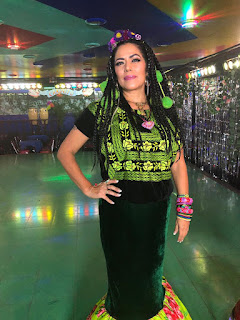Lila Downs - mixed cultures and beautiful music
Pedro Luis Munguia, The News Staff - 7/12/2001
The truly exceptional composers intricately subsume the beauty and complexity of their cultures in their musical interpretations.
For singer-songwriter Lila Downs, of Mixtec-America background, the beauty of the two cultures that shaped her life cannot be any better demonstrated, nor can the presentation of such cultures be more beautifully interpreted.
In Lila's music, we are privy to her many cultural secrets. The pulsing rhythms of Sandunga transport the listener to a remote Mixtec village, to a Mexican City and to the heartland of the U.S.
When she first arrived from the United States and settled in Tlaxiaco, on the Mixtec Oaxaca mountain chain, people in the vicinity would come to ask her to translate letters written in English. Once she was caught off guard when a woman wanted to know what was on a letter she had received from U.S. authorities. It stated her young son had been killed while attempting to swim across the Rio Grande.
Her third recording La Linea/Border is devoted to Mexican migrants, especially those who pass away while attempting the dangerous journey. And because Lila's songs are always an invitation to share in the culture that so inspired her, La Linea is also an homage to all who have felt that a better life, a better day, a better moment may be just over the horizon.
Mixtec (or as they call themselves, Nuu-sabi) migrants don't journey north with luggage or spare clothes - just hundreds of years of rich cultural experiences passed down from generation to generation. They may not bother with the details of academic explanations of the whys and hows of their ways, but they joyfully explain every stitch embroidered on the traditional huipil - like the splendid yellows and reds on the shirts Lila frequently dons at her concerts.
Some may argue that a genuinely Mixtec childhood is necessary to convey the true emotions and experiences of the culture, but for a songwriter, it is far more important to be able to universally convey the dynamics and depth of the culture independent of whether or not one is wholly or just partly a product of that culture.
Her most touching song about Mixtec women is about the well at San Andres Chicahuaztla - "the wind well" - where unhappily married women throw themselves to their deaths. Her international audience cries for the women because it empathizes with the feeling of desperation that touches people of all cultures.
The rich Mixtec culture is a fountain of inspiration for Lila, yet she is also half American. In one song she makes a reference to the Okie's - 1930s migrant farm workers displaced from Oklahoma to California. As with the women of the well, Lila touches people wholly outside the Oakie culture because she sings of universal emotions by tapping into personal cultural experiences.
Wittiness also colors her songs on La Linea. The fifth track "Hanal Weech" introduces the audience to Yucatec humor. "You smell like an armadillo," so use some perfume, says the male Romeo to his lover in a Mayan-language cumbia.
She also recalls the pain and hopelessness we feel when we remember victims of injustice. Songs like "Acteal Smoke" and "Sale Sobrando" put words to the anger we feel after years have gone by and excuses abound and no justice is made.
Lila has also found inspiration in others. "Mi Corazon me recuerda," a poem by the famous Chiapas born Jaime Sabines, is a beautiful reminder of our short stay in this world. She also sings "La Martiniana" by Oaxacan Andres Henestrosa and Ernesto Pesqueda.
"Transito" is a 1998 piece inspired by Mexican poet Maria Cruz. The song describes Mexico City as a place of indigenous migrants from the perspective of a migrant.
A special mention should go to the versatile Celso Duarte on harp and violin, Chucho Mendoza on bass guitar and Carlos "Pelusa" Rivarola on percussion.
FUENTE




Comentarios
Publicar un comentario